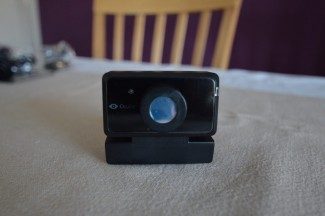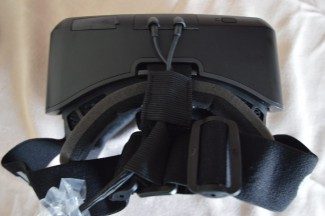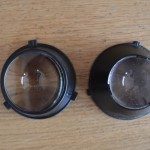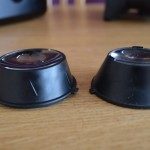Inherent Display Artefacts and What Can Be Done About Them
I mentioned in my Day One summary that I’d come across two issues with the DK2’s display. The noticeability of these issues will vary from user to user and application to application, but they represent issues that will need be either fixed or diminished in order for the VR experience promised.
True Black Smear: I noticed this effect almost immediately after dropping myself into the Oculus World demo for the first time. The issue manifests itself during motion when focussing on a high contrast area of the scene (in this case the dark handrail on the stairs) then moving your head. This results in a nasty smearing effect reminiscent of the old DK1 panel blur, albeit limited to the area of the scene in question. This is an issue recognised by Oculus – Boone Calhoun of Oculus VR commented on the issue recently:
We will have a fix for reducing this artifact. The artifact appears when a dark pixel becomes much brighter in the following frame.
There is a workaround of sorts for this issue which is actually implemented in the DK2 version of the Technolust demo but unfortunately has its own side effects. By converting any true black to RGB (1,1,1) it removes the black smear issue but any dark scene then is overlaid with a subtle green mist.
As Boone has stated, this is a hardware issue for which Oculus have a fix to affect at the software level. We’ll report back once we have further new on this.
Micro Stutter: Anyone who’s ever run any dual GPU solution will probably recognise the term ‘microstutter’. It was an artefact borne from framepacing issues caused by nVidia SLI and AMD Crossfire drivers when running more then one graphic scard in your gaming rig. Well, that effect seems also to be present with the DK2 and possibly for similar reasons.
When moving your head around a scene, the scene updates appear to pause for fractions of a second, producing a jumpy, stuttery image. This seems application dependant (and perhaps strapped to frame rate consistency). It was most evident in Elite: Dangerous although I noticed similar issues when playing Technolust too.
Again though, Oculus are on the case. Chris Taylor tweeted in response to mr article:
@muterobert glad you got all that working. Our driver guys are working on judder issues and already have the problem fixed. Have fun! :)
Sounds like Oculus are on top of these issues big time and that fixes are already known and likely inbound imminently. Great news!
Lenses, FOV and Chromatic Aberration
This section needs to me marked as a WIP. As of writing this, i’ve only spent 2 days with the DK2 and some aspects of this section will rely on calibration experimentation that may take some time. The following views and comment are therefore liable to change. I’ll try to update and add detail as I go.
Lenses: The DK2 ships with just 2 sets of lenses (A-B) versus the DK1 (A-C). The DK2 lenses are noticeably larger than that which shipped with the DK1 meaning, in theory, the sweet spot for the optimal experience may be larger. The housing design remains the same, with the same rotate-and-lift mechanism to remove the lenses. The DK2 has a slightly more reassuring ‘click’ when engaging.
FOV: This is a tough one and I need more time to be sure what I’m seeing is correct. For me, using the ‘A’ lenses with the retraction assembly entirely ‘in’ (i.e. all the way to my face) I could detect what I think was the edges of the panel beneath. The effect reminded me of my short time with the HD prototype last year, but the effect is nowhere near as pronouned. Moving the assembly further from my face removed the effect but replaced it with a more traditional binocular effect instead.
From this experience, I’d say that the DK2 (which uses a 5.6″ panel versus the DK1’s 7″) provided a fractionally lower FOV than the DK1. That said, the differences are small here – frankly it would be churlish to even suggest it was a problem.
Update: After some more viewing and fiddling, my opinion is that the DK2 does provide a noticeably lower horizontal FOV than the DK1. It’s the one aspect of the DK2 I’m slightly disappointed in as the rest of the package is so stellar.
Chromatic Aberration: As the DK2 clearly sport ‘upgraded’ lenses versus the DK1, it’s pretty obvious its optical parameters will be different also. What I noticed after some playtime is that either the software correction for chromatic aberation (the separation of light caused by the Rift’s lenses) isn’t quite ‘there’ yet in terms of effectiveness, or I need to do more work at the calibration stage. Others have noted after I uploaded the Elite: Dangerous video that the aberration correction seems much more stark when viewed without the Rift.
Positional Tracking – Freedom to Move!
Nausea associated with so-called simulator sickness, virtual reality’s nemesis, is a tough problem to crack. The causes a many and varied and every individual stepping into VR reacts a little differently. However, when you reach an acceptable frame rate, remove motion blur and judder and cut latency to indistinguishable levels, there’s only one major hurdle left.
 Your brain is remarkably sensitive to tiny movements your head moves in every day life and when what the eyes see don’t match up to what signals from your inner ear, the brain struggles. DK1 had rotational tracking, which meant that the onboard IMU calculated head position on 6 axis (see image: right), this is great – especially if you can hit a low enough latency between detection of movement and transforming the view to match.
Your brain is remarkably sensitive to tiny movements your head moves in every day life and when what the eyes see don’t match up to what signals from your inner ear, the brain struggles. DK1 had rotational tracking, which meant that the onboard IMU calculated head position on 6 axis (see image: right), this is great – especially if you can hit a low enough latency between detection of movement and transforming the view to match.
So in the DK1, you can move your head forwards/backwards, left/right and tilt left/right – but if you moved your body and head in space, the sensors had no clue that you’d moved which means the view displayed isn’t updated accordingly. This leads to an extremely disconcerting sensation whilst your brain tried to make sense of what’s going on. This can then lead to simulator sickness, and nausea. Some extreme cases I’ve seen only need one incident like this and the affected person can feel unwell for many hours. So what’s the solution? You need positional tracking, so that the headset / application knows its position in 3D space so that any application can update accordingly.
Of numerous possible options, Oculus chose single camera based optical tracking solution. The DK2’s housing has numerous infra-red LEDs embedded which all flash at different frequencies. The camera, packed in with the DK2, not much larger than a typical webcam, faces the user which picks up these LEDs and can use the unique signature to build a positional model of the DK2’s position and orientation. In addition to this the DK2 contains a more traditional IMU providing rotational tracking information. Hey presto, positional tracking!
So, What’s it Like in Practice?
When the camera is setup correctly and the application you’re using hooks into the positional data, something magical happens. Instead of merely looking around, rooted to the spot, you can freely (within reason) move in and out of the virtual scene. Move your head closer to the camera and your virtual head will move into the virtual space. Duck, and you can look under objects. Dodge and lean around doors and lean out of windows to look up at the sky. Within limits, this is all now possible with the DK2 and it transforms the experience – making it immeasurably more human.
Wandering through the Oculus World demo, inspecting branches and peering under light fittings – you feel like you’re really exploring the virtual space. Mooching around your retro-futuristic apartment in Technolust and inspect your Atari 2600, lean over to inspect a suspicious barrel and discover a corpse peering back at you from within. Lean over the edge of the boat in Senza Peso and peer down into the depths of the water underneath. These are naturalistic actions that elicit natural consequences in the gameworld.
 Latency is imperceptible to me at present, the Oculus team have done a fantastic job at tweaking their tracking and rendering chain. The camera’s positioning is somewhat critical – as you might expect. Oculus recommend that you place the camera at roughly eye-level and so that it sits roughly 5 feet from your face. This is fine, except that for most PC users, you’ll probably be sat with your hands on a keyboard no more than 2-3 feet from the monitor the camera is sitting on. In practice, this still works in most cases – but you’re likely to suffer more issues with your head stepping outside of the camera’s field of view. Oculus recommend a joypad based experience, and I can see why. I still need to experiment further with this and look forward to others receiving their kits to share their custom placement solutions.
Latency is imperceptible to me at present, the Oculus team have done a fantastic job at tweaking their tracking and rendering chain. The camera’s positioning is somewhat critical – as you might expect. Oculus recommend that you place the camera at roughly eye-level and so that it sits roughly 5 feet from your face. This is fine, except that for most PC users, you’ll probably be sat with your hands on a keyboard no more than 2-3 feet from the monitor the camera is sitting on. In practice, this still works in most cases – but you’re likely to suffer more issues with your head stepping outside of the camera’s field of view. Oculus recommend a joypad based experience, and I can see why. I still need to experiment further with this and look forward to others receiving their kits to share their custom placement solutions.
The other slight niggle I had was that the rate of movement in game relative to my physical movements seem de-emphasised. That is, I felt I should be moving further in he gameworld than I was and this caused some disconnect. Not sure if this is a conscious tweak at the software side or simply that I’m dead wrong here, again more work is needed to be sure.
I do wonder what solutions developers are going to engineer to deal with the obvious issues of players leaning through virtual objects though. Either the gameworld will have to have natural limitations to prevent this from happening (not particularly realistic) or the player’s view is stopped at the point of clipping – which would cause disorientation and perhaps nausea again. Frankly though, those concerns are far outweighed by the thought of what developers are going to come up with when they set to work with the DK2 – I cannot wait to find out awesome experiences await us.
In general though, the positional tracking solution Oculus have come up with is elegant and supremely effective. It adds the missing piece to naturalistic viewing of virtual worlds and is going to be crucial in tricking us we’re inside those virtual spaces.
—
So there you have it, almost 4,000 words on the next generation Oculus Rift. So many words and yet so much more to say and talk about. It’s an enormous leap in experience over the now usurped DK1 and offers the best possible VR experience the you can obtain commercially right now. What’s more it proves that Oculus have a handle on the challenges that they only began to start solving 18 months ago. The DK2 offers a great target for developers to craft experiences needed for the forthcoming CV1 consumer release and means they can focus on creativity without worrying too much about shifting goalposts of hardware.
Hats off to the team at Oculus, you’ve delivered on your promises and then some.








